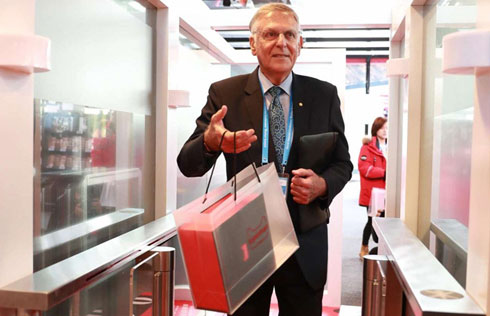Merchandise business still finding its feet
Wang Xiaojing, a 36-year-old mother in Beijing, recently bought a stuffed toy resembling Mickey Mouse hugging a golden pig as a Lunar New Year gift for her 4-year-old daughter.
As a movie fan, Wang had wanted to buy a toy inspired by some Chinese animation hits, but had switched to Hollywood productions as such choices were limited online.
Movie merchandising, a big business netting several times the amount garnered from ticket sales in the West, is still emerging in China.
Movie-based products account for less than 10 percent of the total receipts generated by a film in China, with the other 90 percent coming from box-office grosses and advertising, industry insiders said at a recent seminar at the Beijing Film Academy.
China's film and television merchandising business took off in 2015, followed by a boom in 2016, but the market stagnated from late 2017 until last year, said Ni Yuehong, vice-president of the academy.
"The business has taken shape in the past two years, with more and more studios and companies testing the water in this market," Ni added.
Some films earned phenomenal success. For instance, Monkey King: Hero is Back - an animation hit loosely adapted from the 16th century novel Journey to the West - earned 300 million yuan ($44.4 million) through merchandise sales, one-third of its box office total.
Thanks to stars Liu Yifei and Yang Yang, who were followed by tens of millions of fans on Sina Weibo, the fantasy romance Once Upon a Time saw its merchandise - covering about 60 brands - surpassing 300 million yuan, more than half of the box-office receipts.
The animation Boonie Bears - which has spawned a nine-season TV series, six feature-length movies and a stage show - has seen its merchandise sales reach 2 billion yuan by the end of last year.
Latest available statistics from Alifish, the entertainment licensing unit of internet giant Alibaba, show its licensing business surged by more than 55 percent year-on-year in the first six months of 2018.
Wu Qian, president of Alifish, said merchandising not only adds revenue, but also promotes the popularity of a film franchise.
"A Hollywood sequel may be released several years later. Franchise-related products remind fans of the characters, becoming a tie to bond audiences with the upcoming title," Wu said.
She added that revenue generated by the retail licensing business is still low in China, equating to about 5.6 percent of that in the United States and accounting for 3.4 percent of the global market.
Although there is huge potential, most industry insiders said China's emerging merchandising business faces a host of challenges and hurdles.
Zhu Hairong, deputy manager of the Beijing marketing unit of China Film Co, the country's largest movie studio, said, "Compared with foreign counterparts in the likes of the US and Japan, Chinese filmmakers have yet to have a clear knowledge of merchandising."
He said that appealing merchandise should be conceived when a script is being written, giving creators enough time to design characters or sets-based products.
However, most Chinese filmmakers decide to license or produce merchandise after shooting is completed or the movie is close to being screened.
"Designing should be launched at least six months before the release," Zhu said.
Na Ling, deputy head of the copyright agency department at the Copyright Protection Center of China, said copyright infringement is another problem that dents filmmakers' patience and passion.
She said her department tackles pirated goods with a value of more than 80 million yuan on average every year, nearly four times the figure for licensed products.
Ni, from the Beijing Film Academy, said, "We need to establish a nationwide association for filmmakers, designers and authorities to spur the sound and healthy development of the merchandising business."
Moreover, animation and sci-fi films are most suitable for producing merchandise, but in China the two genres have lagged far behind Hollywood, Ni added.
xufan@chinadaily.com.cn
(China Daily 01/23/2019 page2)














